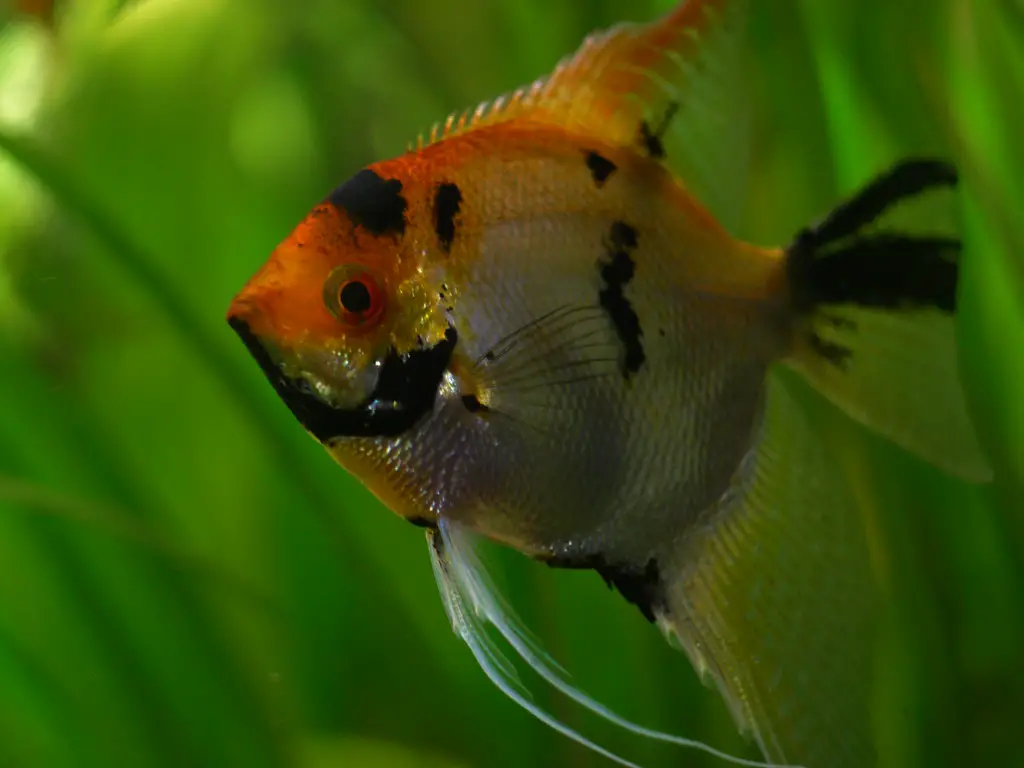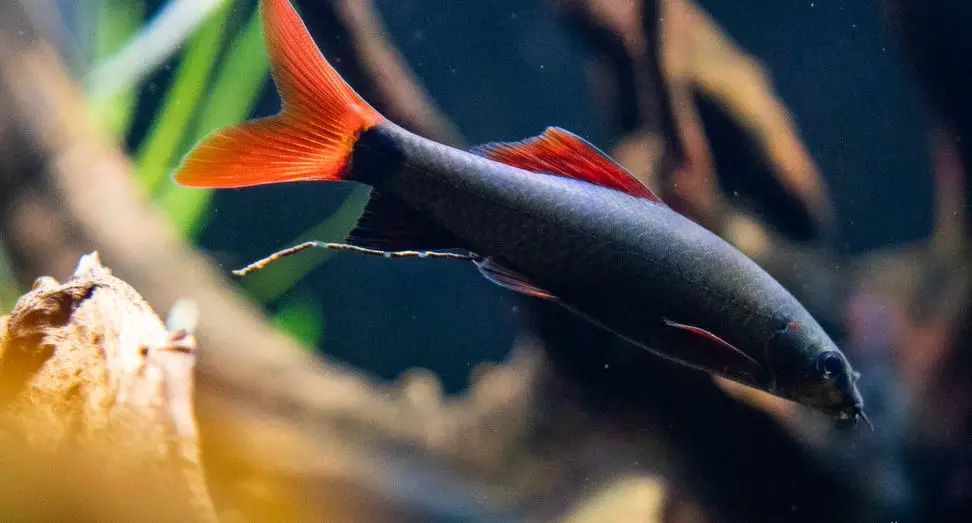Chinese Algae eaters are very easy to care for. Even beginners can handle Chinese algae fish. I don’t need lots of experience to keep Chinese Algae fish healthy in our surroundings. The Chinese Algae eater is the best choice for anyone looking for an algae eater. These fish are known for their ability to consume large quantities of algae. They prefer to live alone and not be social. Although they are easy to care for, aquarists must be wary of them. The fish are tough, but to avoid stress and sickness, tank conditions should mimic that of its original environment.
The Chinese algae eaters are solitary and hostile to fish of a similar size. These active algae eaters work wonders as all-natural freshwater tank cleansers. Their sucker-like mouth allows them to grasp onto rocks and other structures to hold themselves stable in the water. Throughout the wild, they dwell in clear, constantly flowing mountain streams. They spend the majority of their time close to the bottom of the streams, where they consume algae and other trash.
Appearance
Chinese algae eaters lack the colorful appearance of other fish. Their color and pattern are rather subdued. Chinese algae eaters have a body that is either gold in color or light brown with a solid or spotty black stripe running along it. In general, females are bigger and puffier than males.
The fish’s belly is often lighter. A deep black stripe goes with the basic hue. They are long, slender fish with a mouth that resembles a suction cup. The mouth is utilized to adhere to glass, rocks, and other decorations. They are mainly active at night.
Chinese algae eaters have unusual gills with two slits, making them one of the few fish that can breathe without using their mouths. Without letting go of the surface they are holding with their sucker mouth, water can enter via one gill and depart through the other. Although there are certain color variations, they are uncommon.
The Albino Algae Eater is a unique variety with a pure golden color and no black stripes or spots.
Size
The typical Chinese Algae Eater can reach a length of 10 to 11 inches once fully grown. Most breeds bred in tanks remain at or below the 5-inch threshold. Though it appears like 5 to 10 years is more typical. They can survive up to 15 years in a home aquarium with proper care.
Water care
It is crucial to maintain excellent water quality with frequent water changes and sufficient filtration to keep fish healthy. To avoid disease, we must provide them with ideal habitats and maintain high water quality. Therefore, the water temperature must be checked daily along with its filter and other equipment. Water quality could be done at least once a week.
You should change 10-25% of the total volume of water every 2-4 weeks as needed. The aquarists must change filter media monthly to ensure its quality. The perfect pH range for the Chinese fish eater would be 5.8 to 8.
We need to ensure that the tank water is always clean and well-oxygenated to ensure that the fish with its best habitat and conditions. The perfect temperature range for Chinese Algae would be 24 to 28 degrees Celsius. We could also use the heater to maintain optimal temperature for its survival. To create a natural habitat for the Chinese Algae eater, keeping vegetation in the tank must be the very first thing.
Tank Size
Choosing a rectangular tank having more width than height provides an enormous exploring room for these fishes. Chinese algae eaters’ ideal tank would be a minimum of 50 gallons or 50 gallons per fish. But a 30-gallon tank could also be suitable for a juvenile fish. Using 50 gallons tank can be more spacious and provide less stress to it.
Providing a larger tank helps in the overall increment to reach their full potential. One of the most important aspects of caring for the Chinese algae is to keep its tank clean. Chinese Algae Eater is mostly peaceful when they are young, but as soon as they grow older, they tend to become territorial and aggressive towards others.
What To Include In Chinese Algae Eater’s Tank
Since Chinese Algae fishes are found in rivers throughout Asia, we must enrich the environment to mimic their natural habitat. Rivers tend to be warmer side having a lot of places to hide in. To provide it with some natural habitat, we could keep some caves, plants, and hollow decorations. We don’t need a bubbler for this fish. Normal aquarium lights promote plant development and resemble the natural cycle of day and night.
To keep the water temperatures range, these tropical fish demand a water heater. They require proper filtration. Chinese algae eaters are skilled escape artists, so it is advised to use a safe cover. These fishes will perish in water with high ammonia and even nitrate concentrations.
Before adding any fish to the tank, make sure your filter has a mature bacterial colony. Also, every other week partial water change must be performed to keep the toxins in check.
To protect the fish from jumping out of the tank, make sure the tank has a lid, preferably one with a latch.
Substrate
We can add some fine sand substrate and small gravel mix to the tank. Coarse gravel has sharp edges. Avoiding coarse gravel can minimize the scratches on the fish’s body.
Chinese Algae eaters swim in the lower regions of the tank. We could also add some large rocks in the sand. While changing the water, use a vacuum siphon to remove the leftover food and waste substrate.
You can use Aquarium Gravel, Fluorescent Colors, Complements GloFish Tanks, and a 5-Pound Bag for your Chinese Algae Eater.
Lighting
For the Chinese Algae Eater, light is unimportant. Good lighting can enhance the overall growth of algae on plants and decors.
Water Movement
Using another device like a wavemaker is also encouraged for Chinese Algae eaters. They favor water that flows quickly and can get to them even in the tank’s lower level. This will simulate their natural latching behavior, which is a sight to watch.
Decorations
As I said before, we mimic their natural habitat to ensure that the fishes are stress-free. We can add large smooth rocks on the substrate along with caves, Coconuts, PVC pipes, and Malaysian driftwood so that they could have a place to hide and explore.
Disease
Chinese algae-eating fish are not particularly susceptible to any diseases, but they can catch illnesses common in freshwater aquariums.
Ich
Ich is also commonly known as white spot disease. It is caused by the parasite Ichthyophthirius multifiliis commonly occurred due to poor water conditions. Fish with Ich have white spots on their bodies that resemble salt and appear listless and sluggish. The fish will rub their bodies against the tank’s rough surfaces.
Bloating
Overfeeding Chinese algae eaters is likely to be the main cause of bloating. The major sign of bloating would be dropsy. Dropsy occurs when fluid builds up in the fish’s body cavity. Constipation caused by inadequate nourishment also contributes to bloating.
To treat a fish with dropsy, 25% of the water must be changed every two days for two weeks. Reducing the amount of food intake could be the principal treatment for bloating.
Diet
The main diet for Chinese Algae eaters is algae. Therefore, it takes little time to feed Chinese Algae Eaters. As we added rocks to its tank, they adhered to algae-growing rocks and scraped the algae off them. On top of that, we could also supply this fish with a variety of other foods in their diet. Feeding them is one of the easy jobs as they are not picky. They would gobble almost everything, like brine shrimp, bloodworms, and tubifex.
Some of my suggestions would be:
- Omega one pellets
- Ocean Nutrition Instant Baby Brine Shrimp 0.7-Ounces (20 Grams) Jar
- Omega One Freeze-Dried Blood Worms, 0.96 oz
- Hikari Bio-Pure Freeze Dried Daphnia for Pets, 0.42-Ounce
- Hikari Tubifex Worms Fish Food (0.7 oz.) [Set of 2]
Although we can also feed them flakes and pellets, those food are not considered as nutrient-dense as meat. Once a week we must feed them with nutrient-dense food. Both live and frozen foods are all acceptable. But they must all sink to the bottom of the tank. Another excellent approach to occasionally switch up their diets is to include crushed green veggies like zucchini, spinach, and lettuce.
Tankmates
Since Chinese Algae eaters prefer to stay alone, we need to be cautious to choose their tank mates. The foremost rule to remember is not to overcrowd the tank. They will act violently if they believe their area is being crowded and invaded by others. They spend the majority of their time in the bottom of the water column, latching on to and feeding on algae. Fish in the middle and upper water columns are often ignored, but any fish that resembles them in size and behavior will be fought.
Some of the possible tank mates for the Chinese Algae eater would be:
- Molly fish
- Platies
- Zebra Danios
- Minnows
- Tinfoil
- Cherry barbs
- Emperor Tetra
- Dwarf Gourami
Species like Angelfish, Goldfish, and Discus must be avoided. This is due to Chinese Algae Eaters latching onto these breeds and attempting to suck off their slime coats. This can result in parasite illnesses. Just add a few species with different social structures, and then add the Chinese Algae Eater last. This will prevent the Chinese Algae Eater from trying to seize control of the entire tank and making the lesser breeds its easy prey.
Breeding
In tanks and aquariums, breeding Chinese Algae Eaters is extremely difficult and rarely successful. Although some people claim to have produced Chinese algae eaters in very big settings. There are currently no valid reports of their reproducing in aquariums kept at home.
Although the females of adolescent fish are often plumper than the males, this is practically feasible. Meanwhile, the male will grow characteristic tubercles or “horns” on his snout as he gets ready to spawn.
Currently, they are produced commercially on fish farms using hormones.
Conclusion
Overall, you don’t need lots of experience to keep Chinese Algae eaters in our aquarium. However, there are popular fish for beginners. But when it comes to peaceful freshwater fish for aquariums, they might not be an ideal choice. Nevertheless, they do play a big role in cleaning our tank and reducing our responsibility. Chinese algae eaters are a species that requires little maintenance. It is unquestionably a con. Some enthusiasts may consider their size, lifespan, and appearance to be turnoffs.
FAQ
How big do Chinese Algae eaters get?
Chinese algae eaters can reach an adult size of 11 inches.
What do algae eaters eat?
Chinese algae eaters’ main dietary source as adolescents is algae. As they get older, they’ll also develop a preference for protein-rich feeds like bloodworms, frozen or freeze-dried brine shrimp, and sinking pellets.
How many Chinese algae eater’s per tank?
It is preferable to keep Chinese algae eaters in a single tank because they’ll get violent and compete with one another.






